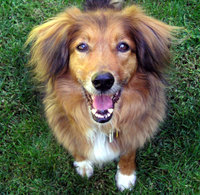The Mixed Breed Dog
common training and behavior problems
The mixed-bred dog comes in every shape, size, color, and temperament. Knowing some of your dogs ancesterial makeup can help you understand his behavioral tendencies. Owners of mixed-bred dogs call us with a variety of issues, the most common are:
- Jumping up on people
- Fearfullness
- Barking
- Nipping
- Aggression
- Jumping on counters
- General obedience
For recommended reading on dog behavior, view our listmania list at amazon.com.
![]()
dogs
From Wikipedia, the free encyclopedia
 A mixed-breed dog (also called a bastard, mutt, crossbreed, mongrel, tyke, cur, or random-bred dog) is a dog that is a mixture of two or more breeds, or a descendant of feral or pariah dog populations. Dogs interbreed freely, except where extreme variations in size exist, so mixed-breed dogs vary in size, shape, and color, making them hard to classify physically. Historically, all purebred dogs have been selected from a mixed-breed population.
A mixed-breed dog (also called a bastard, mutt, crossbreed, mongrel, tyke, cur, or random-bred dog) is a dog that is a mixture of two or more breeds, or a descendant of feral or pariah dog populations. Dogs interbreed freely, except where extreme variations in size exist, so mixed-breed dogs vary in size, shape, and color, making them hard to classify physically. Historically, all purebred dogs have been selected from a mixed-breed population.
Appearance
All possible body shapes, ear types, and tail styles can appear in mixed breeds. Extremes in appearance, such as the flattened face of the English Bulldog or the extremely curled tail of the Pug, seldom survive even the first crossbreeding. Mixed-breeds also tend to have a size between that of their parents.
Mixed-breed dogs can be any size, weight, or color, but some colors are more common than others. No matter their parents' colors, mixed-breeds are often a light-to-medium brown or black, frequently with a white chest and other white markings. The light-brown coat is sometimes called yellow, as personified by the fictional dog Old Yeller. A brown coat with black across the top and sides is also quite common.
Predicting the adult appearance of a mixed-breed puppy is difficult. Even purebred puppies do not look much like the adult dogs they will become, and with mixed-breed puppies it is nearly impossible. If one knows the breeds of the parents, some characteristics can be ruled out; for example, a cross between two small purebreds will not result in a dog the size of a Great Dane. Some breeds tend to pass on their physical traits to mixes more than others. Border Collies and some Spaniels, for example, often produce offspring with similar coats and ears. The crossbred offspring of German Shepherds usually have Shepherd faces and other characteristics.
With each generation of indiscriminate mixing, the offspring move closer to the genetic norm. Dogs that are descended from many generations of mixes are typically light brown or black and weigh about 18 kg (40 lb). They typically stand between 38 and 57 cm (15 and 23 inches) tall at the withers.
Guessing a mixed-breed's unknown ancestry is difficult for even knowledgeable dog observers, because mixed breeds have much more genetic variation than among purebreds. For example, two white mixed-breed dogs might have recessive genes that produce a black coat and, therefore, produce offspring looking unlike their parents.
Temperament and activities
The mature appearance and behavior of purebred puppies is more predictable than that of mixed breeds, including cross-breeds. With purebred dogs, the genetic variations are well documented and a breeder has a fair estimation of what type of offspring a given pair will produce. Even still, there is variation within breeds; for example, two champion sheep-herding Border Collies might produce offspring with no interest in sheep herding.
Overall, mixed breed dogs tend to be healthier. They have more genetic variations than purebred dogs. Often, breeds can be associated with specific health problems. Breeding dogs who are prone to similar health problems greatly increases the chance of health problems in the offspring. By breeding dogs who are prone to different problems, the chances are lowered of serious health problems. Genetic variety increases health.Mixed breed dogs are said to be, on average, no more intelligent than purebred dogs, and both sets feature both slow learners and dogs with high learning capacity. For example, Benji, the hero in a series of films named for him, was a mixed-breed terrier. However, it is more difficult to predict the trainability of mixed-breed dogs when they are very young. This is controversial, since there's a difference between intelligence and plain subservience. Most Golden Retrievers are eager to please, but a mix of a Golden with the independent Siberian Husky could inherit either dog's trainability—or could result in a dog with the endurance and athleticism of the Siberian and the trainability of the Golden.
Wikipedia contributors, "Mixed-breed dog," Wikipedia, The Free Encyclopedia, http://en.wikipedia.org/w/index.php?title=Mixed-breed_dog&oldid=88680051 (accessed November 23, 2006).
![]()
Breed Specific Behavior
We encourage the potential dog owner to fully investigate the various breed characteristics that make up the mixed breed dog before acquiring a new dog. We will continue to add to and update this section over time.

